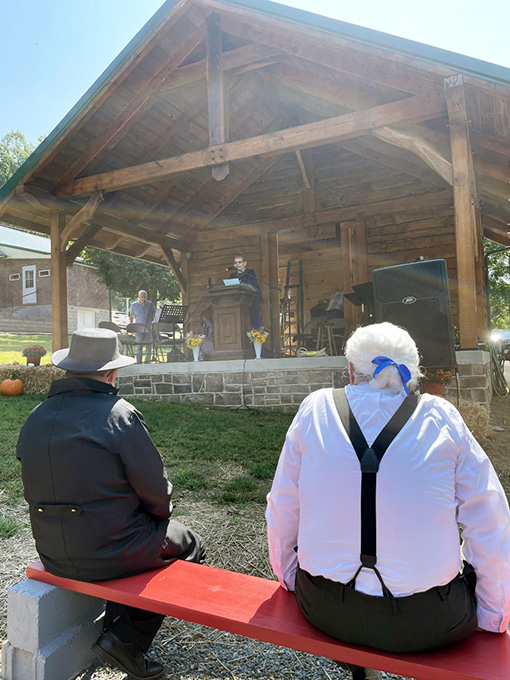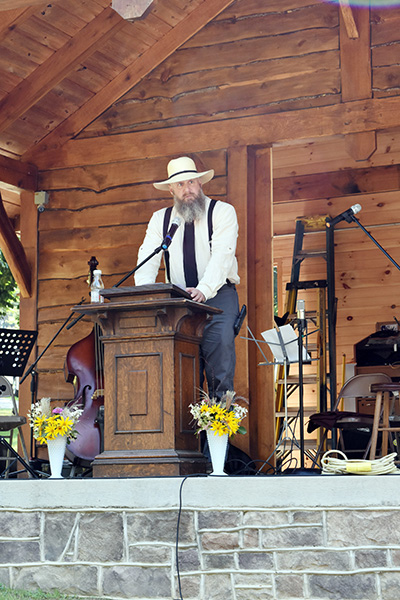Celebrating Its 200-Year Anniversary
Joan Bittner Fry
Jacob’s Church, located on Harbaugh Valley Road in Fairfield, Pennsylvania, celebrated its 200th Anniversary in September. It was a two-day event, with old time dress, music, and folks talking about the history, food, and fellowship of the church, along with historic displays of the Church. Joan Fry, Danny Harbaugh, and Pastor Richard Daughtridge all gave unique historical interpretations of the church’s steadfast history. Joan Fry’s research is presented below.
Jacob’s Church was organized in the year 1822 under the pastoral care of Rev. David Bosler, then pastor of the Emmitsburg Charge (group of local churches). For the want of a church building, services were held in the schoolhouse that stood on the lot that was owned by the congregation, and upon which the church now stands. In the following year, 1823, the stone edifice that now stands as a monument of our forefather’s zeal and love for the cause of Christ, was erected as a place of worship for the congregation. Although many and serious difficulties presented themselves in the completion of the project under contemplation, they were overcome and the undertaking was carried forward with success.
Jacob’s was first mentioned as a congregation of Classis in 1831 as Herbach’s Schoolhouse in the Emmitsburg Charge. In 1834, the charge consisted of Herbach’s (also called Herbach’s Schoolhouse, Harbaugh’s, Harbaugh Valley, Valley, and Jacob’s). Emmitsburg, Millerstown, Taneytown, and Baust completed the charge.
Yost Harbaugh, a Swiss, came to this country in about 1736. He was twice married. There were six children by the first marriage and four by the second. George Ludwig and Jacob Harbaugh, oldest sons of Yost Harbaugh by the first marriage, settled this valley shortly after 1760. They were all born in Switzerland. The second child of the above-named Jacob Harbaugh was also named Jacob. It is for this son, Jacob, that this church is named. He was a prominent mover and a good supporter in the erection of the church. He was quiet in his habits, and tall and stout in his person. The tombstone erected in his memory reads thus:
In memory of Jacob Harbaugh
Born March 21, 1763,
Died December 16, 1842,
Aged 79 years, 8 months, and 26 days.
About two months ago, I decided to attack a giant file cabinet located at St. John’s Church that was full of St. John’s Church files, Jacob’s Church files, and St. Stephen’s Church files. I took them all to my house. The information was then sorted—prior to 1900, then by decades from 1900 to 1922. From a decade stack, each was sorted into years (23 stacks). Sorting a decade at a time made the activity workable and not so overwhelming.
Monthly joint consistory reports and annual reports were sorted by years and months, placed in sheet protectors and then in notebooks. In the future, this may be appreciated as a history of the churches. Information from the sister churches was separated to be given to each church of the charge upon completion.
Among those thousands of pages and publications, there was the following treasure:
This book – It is my wish to be kept in sacred trust for the Sabillasville Charge. Milton H. Sangree February 10, 1909.
Rev. Sangree was 77 years old when he wrote this little gem. He served the Sabillasville Charge, which consisted of St. John’s in Sabillasville, St. Stephen’s in Highfield, and Jacob’s in Fairfield from January 8, 1906 to January 31, 1909.
REOPENING OF ST. JACOBS
We know that Jacob’s Church is not St. Jacob’s but named after Jacob Harbaugh, who may or may not have been a saint. However, Pastor Sangree used St. Jacob’s in this writing and so to be authentic, so will I.
The honored church of St. Jacob’s, built from 1823-1825, was found to be in danger of destruction through disintegration of mortar and action of water and frost on parts of the walls.
A general interest was expressed throughout a larger circle of the community and persons far removed to whom the memory of St. Jacob’s was dear, to have this venerable structure repaired and beautified.
This decision took practical shape in a general movement in the congregation and its friends during the summer of 1907.
The walls were straightened, some ancient timbers replaced; the outer walls neatly pointed; and a slate roof replaced the worn-out shingled roof.
The interior of the church was finished in imitation Fresco, the building neatly painted within and without. The cost of these repairs was approximately $400.
On August 31, 1907, the work was finished, and on Sunday, September 1, 1907, with a house filled with enthusiastic and joyous people, St. Jacob’s was reopened for the worship of the Triune God, for which it was built and set apart by devoted people who are only a sacred memory today.
The congregation sang as one of the hymns for the occasion, a hymn sung at the laying of the cornerstone of St. Jacob’s in 1823.
Rev. James R. Lewis, a former pastor, made a most fitting and beautiful historical address.
Rev. Milton H. Sangree 1832-1911
Rev. Milton H. Sangree was born at Smithsburg, Maryland on November 7, 1832. Later, his parents moved to McConnellsburg, Pennsylvania, where he received his early education in the public schools and the summer subscription school. He then entered Tuscarora Academy. For eleven years, following his graduation from the academy, he taught in the public schools.
A Civil War Veteran, he enlisted at the stated age of 33 in Hollidaysburg, Blair County, February 24, 1865, and mustered into federal service at Harrisburg February 28 as a private with the 78th Pennsylvania Infantry in the second organization of Co. K. Promoted to 2nd lieutenant to date March 2, he was honorably discharged with his company September 11, 1865.
After the war, his intention was to take up farming, but through Rev. C. U. Heiman, he decided to study for the ministry. He graduated from Mercersburg Seminary in 1871 and was licensed in May of the same year by Mercersburg Classis. He was also an oilman and a writer. In 1872, he was ordained and installed pastor of Bloody Run Charge, Bedford County, Pennsylvania.
He served the following charges: Bloody Run, Pa., Alexandria, Pa., Arendtsville, Pa., Steelton, Pa., 4th Church in Harrisburg, Pa., and Sabillasville, Md. He died October 18, 1911, at age 79.
Today, on the 200-year celebration of Jacob’s Church, we honor the former pastors who served Jacob’s and its sister churches.
Rev. David Bossler 1822, Elias Heiner 1833, Samuel Fisher 1836, Andrew Freese 1840, William Philips 1843, H. I. Comfort, A. E. Gilds, Henry Wisler 1875, A. B. Stoner 1885, Welty 1886 who was also a medical doctor, J. Meyer 1888, James Lewis 1891, Cyrus Cort 1896, Charles Bushong 1903, Milton Sangree 1906, M. L. Firor, W. Mehrling, Wilmer Long 1927, Claude H.Corl 1930-1936, Darwin Gass 1937, Edwin Werner 1940, (Rev. Claude Corl returned to the Sabillasville Charge in 1947 after serving in the Army Chaplain Corps in the African and European Theaters. The second time, he served from 1947 until his retirement in 1974.) Vernon Firme 1973, and Galen Hahn, 1988. After Rev. Hahn, there was not a three-church charge.
I want to report that my living room is still a little cluttered, but as our forefathers and foremothers showed me, I hope to keep at it until the church records, which are so important for the future, are in one place for all to appreciate.
Let us pray Lord, thank you for people of the past and people of today for blessing us with the knowledge of yesteryears. May love for your church continue so that future generations will praise you! In your name, Amen.

Joan Fry recounts the history of Jacob’s Church.

Parishioner Danny Harbaugh shared his version of Jacob’s Church history.
Photos by Deb Abraham Spalding

